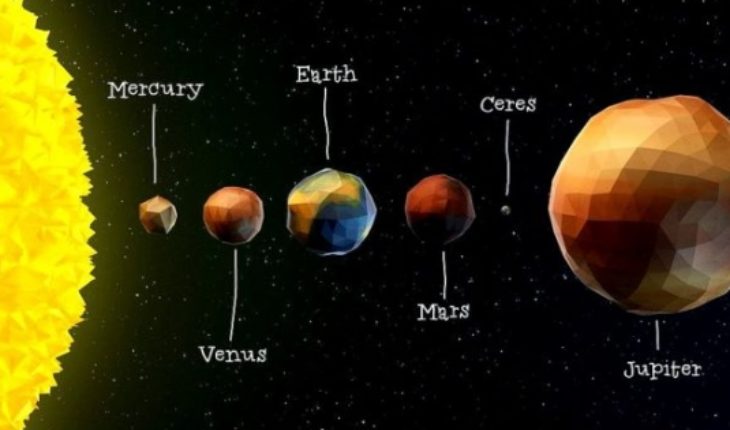but the excitement turned to desperate on a few weeks later, when the small planet was lost among a plethora of stars. Astronomers had no idea where he had gone.
Days later, however, a natural 24-year German of Brunswick, announced that it knew where to find the lost planet and said astronomers to where in the night sky aiming their telescopes.
As if by magic, Ceres reappeared.
Overnight overnight, Johann Carl Friedrich Gauß became a celebrity of science.
The magic of mathematics of course, your great act of astronomical prediction was not an act of magic. It was an act of mathematics.
At the end of the 18th century was already predicted the existence of a planet in the vicinity; the astronomers searched him and found him, but by chance.
Gauss used mathematical analysis to find out what path would take the heavenly body below.
Gauss was known in its area for its intelligence. Find Ceres made it famous. Eventually, he came to be like a God in the mathematical world… and with much Razonel method Gauss invented to find the route Ceres is one of the most important in all of science tools because it allows us to convert a lot of observations jumbled into something significant.
Referred to as the function Gaussian or normal distribution, thanks to her crimes are resolved, medicines are evaluated and political decisions are taken.
From a strictly mathematical point of view, it is probably not the greatest achievement of Gauss, but the impact that has had on so many different areas of Science (and life) is extraordinary.
Who was that young German?
In the Europe of the 18th century, mathematics was an occupation of the privileged, funded by the aristocracy or practiced by amateurs in their spare time.
But one of the biggest that mathematicians and all times, Carl Frederick Gauss, was born poor.
And it could be said that it was thanks to the vision and the patronage of Carlos Guillermo Fernando Duke of Brunswick-Wolfenbüttel, which was able to develop his phenomenal talent.
The Duke of Brunswick-Wolfenbüttel was sponsoring those who had minds prometedorasEn 1791, the Duke offered to pay the University studies of Gauss, who was then 14 years old.
Noble was convinced that a well-educated population was based on the commercial success of Brunswick and was always aware of outstanding students.
Gauss was one of them.
Brilliant at age 15, detected an extraordinary pattern hidden among primes, one of the greatest mysteries in mathematics at that time.
At age 19, he discovered a beautiful construction of a regular figure of 17 sides – a heptadecagon – using only a ruler and a compass, something that had been thought impossible for 2,000 years.
Since the time of the ancient Greece until Gauss made this figure that it was thought that it did not exist, only known rules to construct triangles regular, square, pentagons and a figure of 15 equal sides using only a ruler and a compass, besides all the fig URAs doubling that number of ladosA that age, perhaps to keep abreast with their multiple advances, began keeping a mathematical journal.
Entries begin in 1796 and the last one has the date of July 9, 1814.
In the 19 pages of one of the most precious document in the history of mathematics are reported briefly 146 results as…
March 30, Braunschweig: the principles of which depends on the division of the circle and the geometric division of the same in 17 parts.
June 27, Göttingen: A new proof of theorem aureo all at the same time, from scratch, different and not inelegant.
July 10: every positive integer number can be expressed as sum of as much three triangular numbers although I was so excited with this latest discovery that what they actually wrote in his diary was: later, collected many of these entries of newspapers on the properties of numbers in his first book, published in 1801, “Disquisitiones Arithmeticae“, dedicated to the generous Duke.
In it – among other things – was the basis for a new branch of mathematics, the theory of numbers.
With seven seals Gauss hoped that his work did notable in France, the epicenter of mathematics in Europe. However, to his great dismay, it was not well received by the Paris Academy of Sciences.
To some extent, he was at fault.
Presented their ideas of a so incredibly cryptic fashion that there were those who described the Treaty as a book “sealed with seven seals”.
However, a French mathematician wrote: “your Disquisitioned Arithmeticae long has been object of my admiration and my Studio.”
“the last chapter of this book contains, among other things, the beautiful theorem on equation 4 (x ^ n-1) / (x-1) = and ^ 2 +-nz ^ 2;” I think that you can generalize (…)
“I take the liberty of this attempt to undergo their trial, convinced that it does not disdain to help, with his Council, an amateur enthusiast in the Science you has grown so brilliantly successful“.”
It was the beginning of a correspondence that would have consequences far beyond mathematics.
In November 1806, his protector, the Duke Fernando, was fatally wounded in a battle against the army of Napoleon.
The State of Hanover was under the control of Napoleon and the teachers were forced to pay a tax to the French Government of 2,000 francs, a small fortune at the time.
Gauss refused, putting at great risk.
The Duke could no longer protect it. At the battle of Auerstädt (14 October 1806) reached it a shot and lost eyes. Mortally wounded fled the French forces and died in Ottensen on 10 November 1806Pero the mysterious Monsieur Le Blanc used his influence to make sure to not happen it nothing wrong to the young and brilliant Gauss.
It was only when Gauss tried to thank him discovered his true identity: Monsieur Le Blanc was actually a woman named Sophie Germain.
The extraordinary mathematical lied so they take it seriously and helped solve “one of the most difficult equations” history “for fear of ridicule -accompanying a student, previously have taken the name of M. le Blancto communicate those notes that, without a doubt, do not deserve the leniency with which you answered“, said le Germain.
Gauss responded expressing his astonishment at the turn of events: “the captivating charms of this sublime Science are revealed only to those who have the courage to delve into ellto.
“but if a woman who is infinitely more obstacles to a man to become familiar with complicated problems, manages to overcome these obstacles and penetrate in parts more by their sex and our prejudices” dark, without doubt must have the noblest courage extraordinary talents and superior genius“life without Duke Gauss had done most of the work for Disquitiones while the Duke Fernán” do paid you so devote himself to astronomy, specifically to trace the paths of several celestial bodies: the first Ceres, then Pallas, then Juno.
In those days, explore the night sky was considered as a real science: not so the study of mathematics, particularly something as abstract as the properties of numbers.
But in November 1806, with his employer dead, Gauss was forced to look for a job.
Academic office would perhaps have been the obvious choice, but he had “a real aversion to education”, as students with “unique talents do not want you to educate them through master classes, but to learn by themselves”.
But nobody was going to pay you to investigate, so Gauss accepted a position as director of the Observatory in Göttingen, a small university town in Lower Saxony, now in Germany.
Paid astronomy, mathematics, Noalli spent his time tracing the paths of the heavenly bodies, or what he called… “a couple of lumps of Earth we call planets”.
With everything and that, remember that it was while Gauss tracked “clods of Earth” to the Duke who came up with how to convert a large number of scattered observations into something meaningful.
So how did the scientists love to collect data from observations in the real world.
The problem with the observation of the real world is that it is not generally as accurate. If you trace your findings on a chart, are scattered everywhere. There is a pattern.
Anyone who has tried to calculate the “true” weight knows that it is not easy. Depends on what you’re using, how accurate are your scales, if you’ve eaten or not that day in particular.
How much weight? Gauss had a similar problem with Ceres: there were many measurements of his whereabouts until it disappeared, but there was no indication about its true position.
What he discovered was that if you mapping the real position of Ceres in the night sky with the inaccurate comments of his whereabouts, he obtained a bell-shaped curve.
This is what is known as the function Gaussian or Bell of Gauss.
In a graph is a curve that resembles a simple drawing of a campaign: high in the middle with a long tail that extends outward on each side. Symmetrical about the median line. It was with this that Gauss was able to predict where it would appear Ceres Despuesese method described much, much more than the path of Ceres in the sky.
The height is a classic example: there are some very low people and a few people very high, but most are grouped around the most common height or half.
From the height of people to his readings of cholesterol, the amount of peas in a pod to financial data, a number of observations in chemistry, engineering and agriculture… in bell-shaped curve can be used to characterize the distribution of an extraordinary number of various real-world phenomena.
For this reason, it is an inevitable companion of scientists, economists, sociologists and others.
It is the soul of the statistics.
And the statistics used correctly is the most powerful weapon we have to separate fact from fiction.
Among their practical inventions is the forerunner of the electromagnetic communication, a rudimentary Telegraph with which communicated with his colleague Whihelm WeberLas ideas of Gauss also shed light on the statistical correlation.
It may sound a little technical, but… the length of your arm, for example, is connected to your height? Most likely Yes!
The idea of the correlation between data is also essential for those trying to detect connections between the lifestyles and health problems.
If you trace cholesterol against blood pressure levels and you get many points spread on your graph paper, is there a way through these points, which implies that they are related?
The method Gauss invented to recover the lost planet helps you answer these questions. That is the basis of modern medicine.
The Queen and the Prince the King of Hanover gave him the title of Principegauss was also fundamental contributions to astronomy, the GEODESIC and several branches of physics as magnetism and optics.
But his great love was pure mathematics.
In a letter to a friend wrote: “mathematics is the Queen of the sciences and number theory is the Queen of Mathematics”.
An appointment that is even more powerful, because Gauss was not only a mathematical giant but also a first-class scientist.
And if mathematics is the Queen, given how great was the work of Gauss, the posthumously to King Jorge V Hannover honoured him after his death is well deserved: the Prince of mathematics.
translated from Spanish: Carl Gauss, the mathematician who created one of the most powerful tools of science to find a lost planet
August 19, 2018 |





